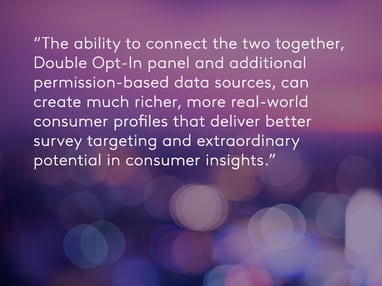The Consumer Insights industry is one that is evolving at an exponential pace. Change of this magnitude is giving us reason to modernize our survey designs, evaluate how we’re sampling and sourcing respondents and pushing us be creative with connecting data sources that maximize research funds and extend the value of the insights we uncover.
Julie Kollman, Kantar’s Chief Research Officer, understands the importance we all play in this evolution – and not just from a supplier perspective. Below she answers questions around survey engagement and design, the difference between “modern” and “mobile,” and the importance of double opt-in (DOI) panel.
 Q: Why is it important that we focus on creating engaging surveys? Does a respondent dropping off from a survey have that much of an impact on DOI panels?
Q: Why is it important that we focus on creating engaging surveys? Does a respondent dropping off from a survey have that much of an impact on DOI panels?
If a respondent drops out of a survey, they are 50% less likely to try another one. That is a very leaky bucket for highly valuable, DOI panels. It costs around $20 to acquire an 18-24 year old -- every dropout turns that $20 into a sunk cost. This isn’t a burden affecting only the managing panel company; it affects our clients' financials as well. As panel management costs go up, the costs of a survey response goes up, too.
How as an industry can we combat this increase of cost? Create engaging surveys that panelists want to complete. Give them a reason beyond financial reward to participate in your research – this means make it fun, rewarding, and most importantly, worth their free time.
Q: The market research industry, particularly the companies who manage DOI panels, have been preaching the need to ‘go mobile’ for years now. Why is it important from a project feasibility standpoint to optimize for mobile respondents?
I continually hear complaints about panel feasibility, but we must be more mindful that, as researchers, we are not blocking the vast majority of panelists from the sample pool (especially hard to reach ones like the young and affluent). Over 60% of panelists sign-up on mobile and prefer to do surveys on mobile. Yet about 40% of surveys do not allow smartphones to participate in surveys, which creates significant bias in the sample. Even those that allow smartphones are more likely to provide the respondent with a poor experience, due to the design. If a survey is designed well and open to all devices, that immediately increase sample capacity by over 20%.
In addition to this, trying to maintain panel capacity with non-mobile panelists is expensive – three times more expensive. And this goes back to the previous point – when panel management costs go up, so will the cost of survey responses.
Q: For the past year, Lightspeed has been expressing the importance of modernizing surveys. In your opinion, what’s the difference between a “mobile friendly” survey and “modern” survey? And why should researchers care?
A “mobile friendly” survey is one that can be taken on a mobile device. It doesn’t necessarily mean the survey is optimized for mobile respondents. However, a “Modern”, respondent-friendly survey is more than mobile compatible. First, length is absolutely critical – we must strive to get all our surveys to be under 15 minutes. Drop-out rates increase exponentially from 10 minutes onward – generally doubling from 11 to 15 minutes, and doubling again between 15 and 25 minutes. But even long surveys can be made engaging, with low dropout and high quality data.
Modern, respondent-friendly surveys are NOT just about length and mobile optimization. Modern surveys are designed with the respondent in mind. This means they are:
- Written in consumer language and consumer style, eliminating patronizing instructions and jargon.
- Designed to be enjoyable to complete – simple, gamified if possible, interesting.
- Designed to be delivered well on a smartphone – even if they are not completed on a smartphone. Smartphone design forces best practice design that makes ALL surveys better for the respondent.
Why should researchers care? Modern, respondent-friendly surveys reduce dropout rates by two-thirds and increase respondent satisfaction by 30%. Happier respondents mean lower costs for each survey and better quality data.
Q: With the vast amount of “big data” available to researchers, is survey data collection a dwindling need for consumer insights?
Survey data collection is – and will remain – foundational to understanding consumers. “Big data” cannot replace it. It will therefore remain foundational to Lightspeed and Kantar’s business model.
In today’s GDPR world, it’s also becoming increasingly important to source permission-based respondents. Having survey data fielded by trusted data sources can enhance other “big data” sources, and create actionable insights. The ability to connect the two together – i.e. double opt-in panel (where the respondent is asked to complete an extra later of email verification) and additional permission-based data sources – can create much richer, more real-world consumer profiles that deliver better survey targeting and extraordinary potential in consumer insights.





